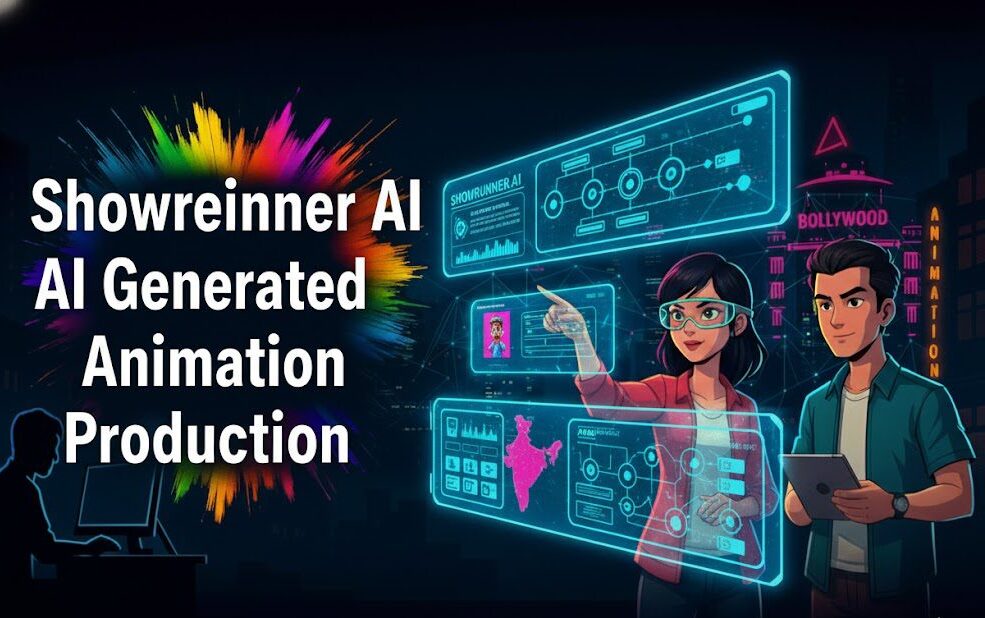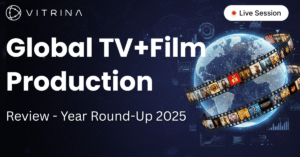How to Master Showrunner-AI-Generated Animation Production

Introduction
The demand for high-quality, high-volume animated content—from episodic series to feature films—has placed immense pressure on traditional production pipelines.
Studio executives face a complex challenge: how to increase throughput without exponentially expanding overhead or compromising the unique artistic vision that audiences expect.
This friction between creative ambition and financial necessity creates a critical bottleneck in the content supply chain. We are now at the inflection point where generative technologies are stepping in to break this deadlock.
This strategic guide provides a definitive framework for integrating showrunner-AI-generated animation production into your content strategy, ensuring faster asset creation, optimized workflows, and sustainable growth.
Key Takeaways
| Core Challenge | Strategic Solution | Vitrina’s Role |
| Fragmented workflows and production bottlenecks slow time-to-market for animated content. | Implement AI-powered creative production for rapid ideation, asset generation, and workflow automation. | Provides deep intelligence on AI-driven content creation trends, specialized AI-native vendors, and executive contacts for strategic partnering |
Understanding the Genesis of Showrunner AI Animation
Traditional animation production is characterized by highly manual, sequential processes. Storyboarding transitions to animatics, assets are meticulously modeled, rigged, and textured, and finally passed to the rendering farm for final output—each step representing a potential point of delay and budget escalation.
Even incremental changes to a character model or environment can cascade across the pipeline, costing days or weeks of corrective labor.
The goal of showrunner-AI-generated animation production is not to replace human creativity, but to automate the computational and repetitive labor inherent in the pipeline.
These advanced models leverage deep learning to understand narrative structures, character styles, and animation physics.
They transform simple text prompts or low-fidelity sketches directly into high-fidelity, production-ready assets and sequences.
This fundamental shift means that creative intent can leapfrog tedious intermediary steps, radically accelerating the time from script development to final sequence
Why Traditional Animation Production is a Bottleneck
For any content buyer or executive managing a pipeline, the term “bottleneck” often translates directly to missed market opportunities.
The typical production cycle for a single season of an animated series can span 12 to 18 months. When market trends shift or a competitor announces a breakout hit, your studio must pivot quickly, but the legacy production model resists agility.
The primary bottlenecks include:
- Asset Creation Lock-in: Changes to design or style midway through production necessitate significant back-tracking and asset replacement.
- Version Control and Collaboration: Coordinating revisions across global teams and diverse vendors creates administrative burdens that compound daily7.
- Rendering and Post-Production: Render times remain a critical choke point, particularly for complex 3D environments or high-resolution feature film assets.
Defining the Showrunner AI Model
The Showrunner AI concept represents the culmination of generative tools designed specifically for long-form, narrative content.
Unlike earlier AI art generators focused on single images, this model is designed to maintain continuity, character consistency, and narrative logic across hundreds of scenes and multiple episodes.
Showrunner AI systems accomplish this by operating as creative co-pilots, interpreting top-level creative directions and managing the low-level execution details.
They generate initial character blocking, produce background assets, create variations of lighting and mood, and automate the tedious tasks of generating in-between frames for movement. The human creative remains in the “showrunner” role, directing the AI model’s output and making the final quality decisions, while the machine handles the volume and velocity of asset creation.
The Core Challenge: Integrating AI into the Existing Animation Supply Chain
For enterprise media companies, integrating generative tools into a tightly controlled, high-stakes workflow is rarely a simple drag-and-drop exercise.
It demands not only technology adoption but a cultural and structural overhaul of the traditional animation production service model.
Executives must address three key challenges: the technical hand-off, maintaining quality consistency, and justifying the significant initial investment.
Bridging the Gap: The Hand-off from AI to Human Workflow
The major pitfall in adopting AI tools is the failure to manage the transition layer where AI-generated content enters the established human-led pipeline. Raw AI output is rarely pixel-perfect. It requires professional human oversight for editing, final compositing, and quality control (QC).
If the AI tools operate as isolated silos, the supposed efficiency gains vanish in complicated export/import cycles and metadata loss8. The solution lies in interoperability.
Successful adoption requires selecting AI platforms that provide open API integrations and industry-standard output formats (e.g., OpenUSD, IMF) that seamlessly feed directly into existing editorial, VFX, and finishing systems.
Maintaining Creative Fidelity and Consistency
The challenge of maintaining character and stylistic consistency is compounded when the pipeline relies on automated generation.
Executives must ask: Can the AI maintain the specific, nuanced “look” across a five-year production run, especially as the underlying generative models rapidly evolve?
- Custom Model Training: The answer is deep customization. Studios must prioritize vendors offering tools that can be trained on proprietary, copyrighted IP and artistic style guides. This creates a “walled garden” model, ensuring that the AI’s output adheres strictly to the show’s canon and creative brief.
- Feedback Loops: Implementing rigorous, immediate feedback loops allows human supervisors to course-correct the AI’s output instantly, rather than addressing deviations in the final QC phase.
The Cost/Benefit Equation for Large-Scale Projects
The cost of integrating, customizing, and training AI models is high, requiring a substantial capital expenditure. The return on investment (ROI) is realized not just through raw output volume, but through demonstrable reductions in overall production time and the associated costs of labor and re-work.
This calculation is complex because it often involves multi-party contracts with vendors and production houses.
I recommend benchmarking the AI investment against three key metrics: reduction in time-to-market, reduction in iteration cycles (re-work hours), and the proven capacity of potential vendors to scale their technology globally for co-production partners.
Only quantifiable intelligence on project timelines, financing, and vendor capacity can accurately de-risk this decision.
Strategic Pillars for Showrunner-AI-Generated Animation Production Success
Transitioning to a successful showrunner-AI-generated animation production model requires strategic direction from the executive level.
This involves shifting from traditional networking to a data-driven approach for identifying partners and managing project intelligence.
Data-Driven Pre-Production and Asset Management
In an AI-centric model, “data is the new IP.” The metadata associated with every generated asset—who created it, which prompt was used, when it was modified, and which version is cleared for final use—is as valuable as the animation itself.
- Granular Tracking: Effective pipeline management requires granular tracking of every content asset. This must include comprehensive metadata mapping, linking every project stage to the companies, creative executives, and service vendors involved
- Informed Pre-Buy: Distributors and streamers gain a competitive advantage by accessing and tracking projects in the critical pre-production stage when AI tools are deployed. Visibility into which studios are using AI, on what scale, and for which genres, enables smarter pre-buy and co-financing decisions, mitigating the risk of financing projects destined for a bottlenecked traditional pipeline
Vetting Partners for AI-Native Integration
Traditional criteria for vetting a vendor—past credits and reputation—are insufficient for AI production. Executives must instead qualify partners based on their technological sophistication and deep integration capabilities.
Key questions during the vendor selection phase should center on:
- API Readiness: Does the vendor offer native APIs for seamless integration with in-house CRMs (like HubSpot or Salesforce) for pipeline fueling and automated lead scoring?
- Specialist Focus: Does the studio specialize in a niche AI domain, such as photorealism, procedural effects, or unique character-style preservation? This focus often indicates higher quality and proprietary technology compared to generalist studios
- Geographic Reach: Where are the talent and render farms located? The platform should facilitate discovery of emerging and niche vendors across underrepresented regions, including Latin America, Africa, and Southeast Asia, offering lower-cost options and diverse creative talent pools
How Vitrina Helps
Navigating the complexities of integrating showrunner-AI-generated animation production requires intelligence that transcends traditional contact lists and fragmented trade reports.
Vitrina is specifically engineered to provide the data and connectivity required by high-level media executives.
The platform functions as a centralized intelligence layer, tracking global film and TV projects across 100+ countries, linking these projects directly to the companies, financing partners, and verified decision-makers involved
For animation studios seeking to scale their output or executives looking to acquire AI-powered content, Vitrina’s capabilities act as a force multiplier.
You can search directly for production houses tagged with niche specializations, such as “VFX pipeline automation” or “animated feature films”.
Its CRM integration, supporting HubSpot and Salesforce, allows sales and BD teams to push highly qualified leads—including companies currently in the development stage—directly into their pipelines, transforming the acquisition cycle from months of manual research into daily, data-driven action This ability to map the complex interdependencies between projects, companies, and key contacts—in real-time and globally—makes informed business development and strategic content acquisition possible
Conclusion
The future of entertainment production lies in the smart marriage of human creativity and automated technology.
Successfully adopting a showrunner-AI-generated animation production model is not simply a matter of acquiring new software; it is a critical shift in strategic and operational mindset.
It requires replacing fragmented data silos with a unified intelligence structure to maximize efficiency, mitigate co-production risks, and ensure creative consistency from concept through delivery.
By adopting a data-first approach, focusing on verifiable vendor credentials, and securing direct access to decision-makers, executives can transform their animation output from a burdensome bottleneck into a highly scalable, profitable asset.
Platforms like Vitrina empower this transformation, streamlining discovery and fostering connections that enable faster deals and smarter creative choices.
Harness this specialized market intelligence to de-risk your investment and establish global leadership in the future of animated content.
Frequently Asked Questions
Showrunner AI refers to advanced generative models and tools designed specifically for long-form, narrative content like animated series. The goal is to automate repetitive tasks, maintain visual and character consistency over many scenes, and accelerate the time from script to final animated sequence.
AI automates several tedious parts of the pipeline, primarily asset creation, texturing, rigging, and generating in-between frames. This shift frees up highly skilled human labor for creative refinement and high-value problem-solving, significantly accelerating the pre-production and animation phases.
While AI excels at rapidly generating assets and preliminary sequences, high-end feature film quality still requires significant human oversight and expertise in final lighting, compositing, and visual effects (VFX) finishing. The tools function best as a creative co-pilot, not a replacement for professional artists.
The primary ethical concerns relate to intellectual property (IP) and data licensing. Ensuring that the AI models are trained only on licensed, ethically sourced data—and clearly defining the ownership and usage rights of the resulting generated content—is a critical business and legal consideration.

























